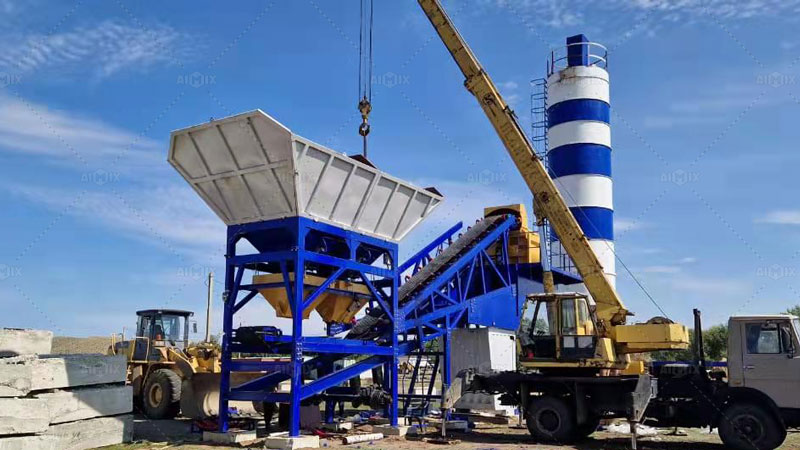Does the Installation of a Mobile Concrete Plant Require a Foundation?
Contents |
[edit] Introduction
The rapid pace of modern construction demands equipment that is flexible, efficient, and easy to deploy. Amongst the most versatile tools in the construction industry today is the mobile concrete plant. Known for its portability and ease of setup, this type of batching plant is increasingly used in roadworks, bridge construction, and other infrastructure projects. However, one common question often arises amongst contractors and engineers: Does a mobile concrete plant require a foundation? The answer depends on several factors, including site conditions, plant configuration, and production requirements.
Before diving into the details, it's essential to understand the role foundations typically play and how mobile plants are designed to operate without them in most cases.
[edit] The Purpose of a Foundation in Concrete Plant Installations
In traditional stationary concrete plant installations, a concrete foundation is necessary to ensure stability, levelness, and load-bearing capacity. The foundation anchors heavy components such as cement silos, mixers, and aggregate batching machines. It also helps prevent settlement or movement during production, especially when the equipment is used continuously at high volumes.
For mobile concrete batching plants, the design concept changes significantly. These plants are built with mobility and fast installation in mind, often mounted on steel frames, skids, or trailers. This raises the possibility of skipping a conventional foundation entirely.
[edit] When Foundations Are Not Required
[edit] Designed for Fast Deployment
One of the core advantages of a mobile concrete plant is its ability to be set up without a permanent foundation. Many models are designed with integrated support systems like outriggers or adjustable legs that allow the plant to be levelled and stabilised directly on compacted ground.
In most scenarios, especially for short-term or temporary construction sites, the plant can be installed on:
- Compacted soil or gravel
- Level concrete slabs already available on-site
- Steel plates or wooden mats for additional support
This eliminates the time and cost involved in constructing a dedicated foundation, making it ideal for projects that require frequent relocation.
[edit] Key Benefits:
- Quicker setup: Installation can often be completed within a day.
- Cost-effective: No need for concrete pouring, curing, or excavation.
- Portability: Easier disassembly and movement to the next job site.
[edit] When a Foundation May Be Necessary
[edit] Heavy Production Loads or Harsh Conditions
While most mobile plants are designed for no-foundation setups, certain situations may still call for a basic foundation or platform:
- High production capacity: If the plant is used for continuous large-scale batching, vibrations and material weight might demand a stable base.
- Unstable ground: Soft or uneven terrain may not provide the required support, increasing the risk of tilting or structural stress.
- Extreme climates: In wet or cold environments, a foundation can help prevent waterlogging or frost heave.
In such cases, a lightweight or temporary foundation can be constructed using steel frames, concrete blocks, or compacted aggregate layers. These solutions offer improved load distribution without sacrificing the mobility of the concrete plant.
[edit] Best Practices for Mobile Concrete Plant Setup
To ensure smooth installation with or without a foundation, contractors should follow these best practices:
[edit] 1. Conduct a Ground Assessment
Before installation, inspect the site for soil bearing capacity, moisture levels, and slope. Levelling the surface is essential for plant safety and performance.
[edit] 2. Use Adjustable Supports
Select a mobile batching plant with adjustable outriggers or screw jacks. These features help maintain stability even on mildly uneven surfaces.
[edit] 3. Ensure Proper Drainage
Water pooling beneath the plant can weaken its stability. Install temporary drainage channels or elevate the plant slightly to avoid flooding.
[edit] 4. Plan for Future Moves
If the plant will be relocated often, avoid permanent installations. Instead, use modular supports that can be reused at different sites.
[edit] Conclusion
In most construction scenarios, the installation of a mobile concrete plant does not require a traditional foundation. These plants are engineered for flexibility and ease of use, allowing contractors to bypass expensive and time-consuming groundwork. However, under certain conditions—such as high-volume production or unstable terrain—a temporary or light foundation may enhance performance and safety.
By evaluating site conditions and selecting the right plant features, contractors can take full advantage of the mobility and efficiency these systems offer, while ensuring reliable operation throughout the project lifecycle. Whether you're deploying a plant for a single bridge project or across multiple road construction sites, understanding foundation requirements will help you plan smarter and build faster.
[edit] Related articles on Designing Buildings
- Bearing capacity.
- Building foundations.
- Compensated foundation.
- Continuous flight auger piles.
- Driven piles.
- Footings.
- Geothermal pile foundations.
- Ground anchor.
- How deep should foundations be?
- How to design a pad foundation.
- Micropiles.
- Pad foundation.
- Pile foundations.
- Principles of foundations.
- Raft foundation.
- Rubble trench foundation.
- Screw pile foundations.
- Stepped foundation.
- Strip foundation.
- Trench.
- Trench fill foundation.
- Underwater foundations.
Featured articles and news
A change to adoptive architecture
Effects of global weather warming on architectural detailing, material choice and human interaction.
How big is the problem and what can we do to mitigate the effects?
Overheating guidance and tools for building designers
A number of cool guides to help with the heat.
The UK's Modern Industrial Strategy: A 10 year plan
Previous consultation criticism, current key elements and general support with some persisting reservations.
Building Safety Regulator reforms
New roles, new staff and a new fast track service pave the way for a single construction regulator.
Architectural Technologist CPDs and Communications
CIAT CPD… and how you can do it!
Cooling centres and cool spaces
Managing extreme heat in cities by directing the public to places for heat stress relief and water sources.
Winter gardens: A brief history and warm variations
Extending the season with glass in different forms and terms.
Restoring Great Yarmouth's Winter Gardens
Transforming one of the least sustainable constructions imaginable.
Construction Skills Mission Board launch sector drive
Newly formed government and industry collaboration set strategy for recruiting an additional 100,000 construction workers a year.
New Architects Code comes into effect in September 2025
ARB Architects Code of Conduct and Practice available with ongoing consultation regarding guidance.
Welsh Skills Body (Medr) launches ambitious plan
The new skills body brings together funding and regulation of tertiary education and research for the devolved nation.
Paul Gandy FCIOB announced as next CIOB President
Former Tilbury Douglas CEO takes helm.
UK Infrastructure: A 10 Year Strategy. In brief with reactions
With the National Infrastructure and Service Transformation Authority (NISTA).
Ebenezer Howard: inventor of the garden city. Book review.
Airtightness Topic Guide BSRIA TG 27/2025
Explaining the basics of airtightness, what it is, why it's important, when it's required and how it's carried out.























